Introduction
China is a country with a rich culinary heritage, deeply rooted in its long history and diverse cultural traditions. Its cuisine is celebrated worldwide for its flavours, techniques, and presentation. Chinese food is as varied as its regions, with each province offering unique dishes that reflect its geography, climate, and history. In this blog, we will explore the top 10 traditional Chinese foods that have stood the test of time and continue to delight people across the globe.
- Peking Duck (北京烧鸭)
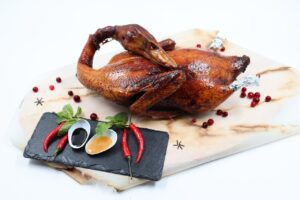
Peking Duck is perhaps one of the most iconic dishes in Chinese cuisine, originating from Beijing. Renowned for its crispy skin and tender meat, Peking Duck is often served with thin pancakes, sweet bean sauce, and finely sliced spring onions. The preparation process is meticulous, involving the drying and roasting of the duck to achieve the signature golden-brown skin. It’s a dish that embodies luxury and tradition, often served at banquets and special occasions.
- Dim Sum (点心)
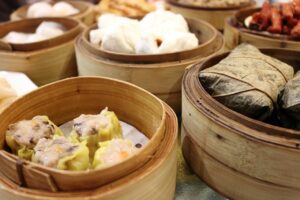
Dim Sum is not a single dish but a collection of small, bite-sized portions typically served in bamboo steamers or on small plates. Originating from Cantonese cuisine, Dim Sum is a staple of southern China and a favourite for brunch. Popular items include shrimp dumplings (har gow), barbecue pork buns (char siu bao), and siu mai (pork and shrimp dumplings). Accompanied by tea, enjoying Dim Sum is as much a social event as it is a culinary delight.
- Kung Pao Chicken (公仔鸡)
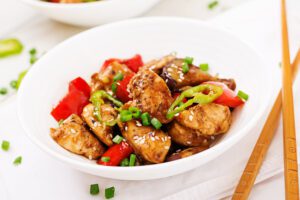
Kung Pao Chicken is a classic Sichuan dish known for its bold flavours and spiciness. Made with diced chicken, peanuts, dried chilli peppers, and Sichuan peppercorns, it delivers a balance of heat, sweetness, and tanginess. The dish’s origins trace back to a Qing Dynasty governor named Ding Baozhen, whose title, “Kung Pao,” inspired the dish’s name. Today, it’s a popular item both in China and abroad.
- Hot Pot (火锅)
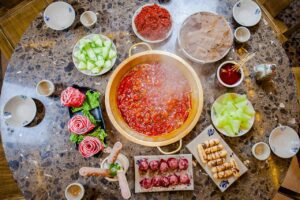
Hot Pot is more than just a dish—it’s an experience. This communal meal involves simmering a pot of broth at the table, into which diners dip and cook a variety of ingredients like thinly sliced meats, seafood, vegetables, and noodles. Originating from Mongolia and popularised in Sichuan, Hot Pot is highly customizable, with broths ranging from mild and savoury to spicy and numbing. The dipping sauces, prepared to individual taste, add another layer of personalisation.
- Sweet and Sour Pork (酸甜肉)
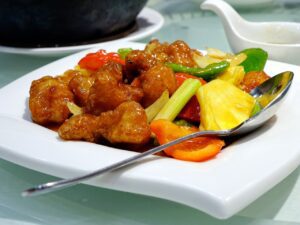
Sweet and Sour Pork is a staple of Cantonese cuisine and a favourite in Chinese restaurants worldwide. The dish features crispy fried pork pieces coated in a vibrant sauce made from sugar, vinegar, ketchup, and soy sauce. The balance of sweetness and tanginess, along with the colourful presentation, makes it appealing to both the eyes and the palate. Pineapple and bell peppers are often added for extra flavour and texture.
- Xiaolongbao (小笼包)
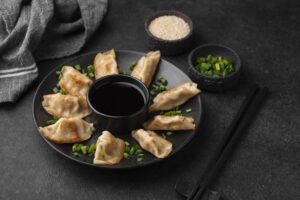
Xiaolongbao, or soup dumplings, are a delicacy from Jiangnan, particularly Shanghai. These steamed dumplings are filled with juicy pork and a burst of hot, flavourful broth that is released when you bite into them. The key to Xiaolongbao is the gelatine-rich filling that melts into soup during the steaming process. Eating them requires skill—a small nibble to release the steam, followed by savouring the soup and the dumpling.
- Mapo Tofu (麻宝豆腐)
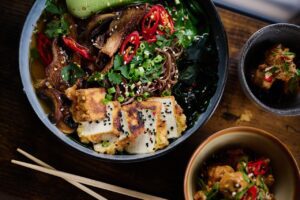
Mapo Tofu is another iconic dish from Sichuan cuisine, famous for its numbing and spicy flavours. It consists of silky tofu cubes cooked in a fiery sauce made from fermented bean paste, minced pork, chilli oil, and Sichuan peppercorns. The dish’s name translates to “Pockmarked Old Woman’s Tofu,” supposedly named after the woman who first created it. Mapo Tofu exemplifies the hallmark of Sichuan cuisine: the perfect combination of heat and aroma.
- Chow Mein (炒面)
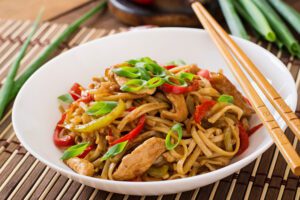
Chow Mein, which means “stir-fried noodles,” is a versatile dish found in many regional cuisines across China. Thin egg noodles are stir-fried with a mixture of vegetables, meat, or seafood, and flavoured with soy sauce and other seasonings. Originating from northern China, Chow Mein has become a globally recognized dish, often adapted to local tastes. Its simplicity and adaptability make it a perennial favourite.
- Zongzi (粽子)
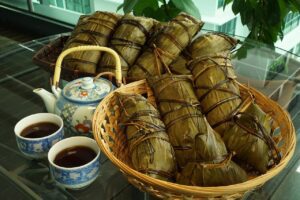
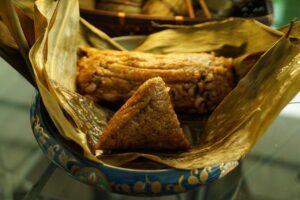
Zongzi is a traditional food closely associated with the Dragon Boat Festival, which commemorates the poet Qu Yuan. These pyramid-shaped glutinous rice dumplings are wrapped in bamboo leaves and filled with various ingredients, such as pork, salted egg yolk, red bean paste, or chestnuts. The combination of savoury or sweet fillings with the fragrant bamboo leaves creates a unique flavour. Zongzi’s cultural significance and delicious taste make it a cherished food during festival times.
- Spring Rolls (春卷)
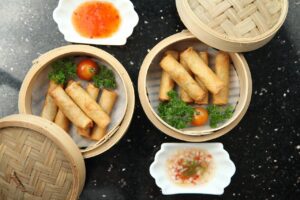
Spring Rolls are a beloved snack or appetizer, especially during Chinese New Year. These crispy, golden-brown rolls are made by wrapping a thin dough sheet around a filling of vegetables, meat, or a combination of both, then deep-frying until crisp. Originating from southern China, Spring Rolls symbolize wealth and prosperity due to their resemblance to gold bars. They are best enjoyed dipped in soy sauce, sweet chilli sauce, or vinegar.
Significance of Chinese Traditional Foods
Chinese cuisine is deeply intertwined with the country’s culture and traditions. Many dishes are associated with festivals, celebrations, or symbolic meanings. For example, eating dumplings during Lunar New Year represents wealth, as their shape resembles ancient Chinese gold ingots. Similarly, noodles symbolize longevity, making them a staple at birthday celebrations.
The emphasis on harmony in Chinese culture is reflected in its food. The balance of flavours—sweet, sour, salty, bitter, and umami—is central to Chinese cooking. Each dish aims to create a harmonious blend of textures, colours, and tastes.
Conclusion
Chinese traditional foods are a testament to the country’s culinary ingenuity and cultural richness. From the elaborate preparation of Peking Duck to the communal joy of Hot Pot, these dishes offer a window into China’s history, geography, and way of life. Whether you’re savouring the spicy kick of Mapo Tofu or the delicate broth of Xiaolongbao, each bite is a celebration of centuries-old traditions.
Exploring these top 10 traditional foods is just the beginning of discovering the vast and diverse world of Chinese cuisine. So, the next time you sit down for a Chinese meal; take a moment to appreciate the stories and craftsmanship behind the dishes. They’re not just food; they’re a delicious bridge to one of the world’s most fascinating cultures.

https://t.me/s/reyting_topcazino/22